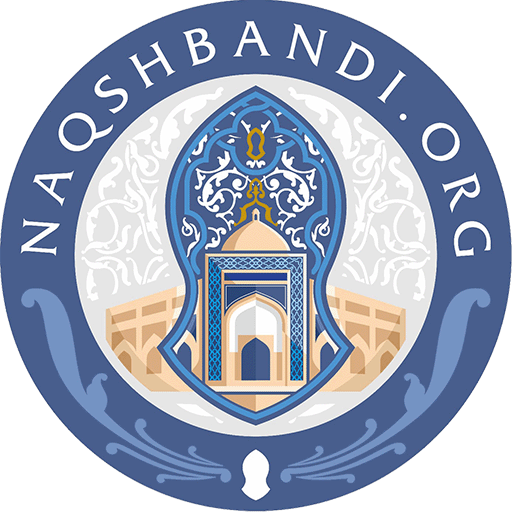إمام الطريقة
The Imam of the Tariqat Shah Baha’uddin Naqshband
In this constellation, we come finally to Muhammad Bahauddan Uways al-Bukhari, known as Shah Naqshband, the Imam of the Naqshbandi Tariqat without peer. He was born in the year 1317 C.E. in the village of Qasr al-جArifan, near Bukhara. After he mastered the شاريجah sciences at the tender age of 18, he kept company with the Shaikh Muhammad Baba as-Samasi, who was an authority in hadith in Central Asia. After the latter’s death, he followed Shaikh Amir Kulal who continued and perfected his training in the external and the internal knowledge.
The students of Shaikh Amir Kulal used to make ذِكْر aloud when sitting together in association, and silent ذِكْر when alone. Shah Naqshband, however, although he never criticized nor objected to the loud ذِكْر, preferred the silent ذِكْر. Concerning this he says, “There are two methods of ذِكْر; one is silent and one is loud. I chose the silent one because it is stronger and therefore more preferable.” The silent ذِكْر thus became the distinguishing feature of the Naqshbandiyya among other tariqats.
Shah Naqshband performed Hajj (Pilgrimage) three times, after which he resided in Merv and Bukhara. Towards the end of his life he went back to settle in his native city of Qasr al-جArifan. His teachings became quoted everywhere and his name was on every tongue. Visitors from far and wide came to see him and to seek his advice. They received teaching in his school and mosque, a complex which at one time accommodated more than five thousand people. This school is the largest Islamic center of learning in Central Asia and still exists in our day. It was recently renovated and reopened after surviving seventy years of Communist rule.
Shah Naqshband’s teachings changed the hearts of seekers from darkness to light. He continued to teach his students the knowledge of the Oneness of God in which his predecessors had specialized, emphasizing the realization of the state of ihsan (excellence) for his followers according to the hadith of the Prophet (s), “Ihsan is to worship God as if you see Him.”
When Shah Naqshband died he was buried in his garden as he requested. The succeeding Kings of Bukhara took care of his school and mosque, expanding them and increasing their religious endowments (awqaf).
Dil ba yor dast ba kor
Succeeding shaikhs of the Naqshbandi Tariqat wrote many biographies of Shah Naqshband. Among them are Masجud al-Bukhari and Sharif al-Jarjani, who composed the Awrad Baha’uddin which describes him and his life’s works including his فتوى (legal decisions). Shaikh Muhammad Parsa, who died in Madina in 822 H. (1419 C.E.) wrote Risala Qudsiyya in which he talks of Shah Naqshband’s life, his virtues, and his teachings.
Shah Naqshband’s literary legacy included many books. Among them are Awrad an-Naqshbandiyyah, the Devotions of Shah Naqshband. Another book is Tanbih al-Ghafilin. A third book is Maslakul-Anwar. A fourth is Hadiyyatu-s-Salikan wa Tuhfat at-Talibin. He left many noble expressions praising the Prophet (s) and he wrote many legal rulings. One of his opinions was that all the different acts and kinds of worship, whether obligatory or voluntary, were permitted for the seeker in order to reach reality. Prayer, fasting, zakat (paying the poor-tax), mujahadat(striving) and zuhd (self-denial) were emphasized as ways to reach Allah Almighty.
Shah Naqshband built his school on the renewal of the teachings of the Islamic religion. He insisted on the necessity of keeping the Qur’an and the teachings of the Sunnah. When they asked him, “What are the requirements of one who follows your way?” he said, “To follow the Sunnah of the Prophet (s).” He continued saying: “Our way is a rare one. It keeps the جUrwat ul-Wuthqa, the Unbreakable Bond, and it asks nothing else of its followers but to take hold of the Pure Sunnah of the Prophet (s) and follow the way of the Sahaba (Companions of the Prophet (s)) in theirijtihad (efforts for Allah).
“The Naqshbandi School is the easiest and simplest way for the student to understand tawhid. It urges its followers to seek a state of complete worship of Allah both publicly and privately by keeping the complete code of conduct of the Prophetic Sunnah. It encourages people to keep to the strictest modes of worship (جazima) and to abandon exemptions (rukhsa). It is also free from all innovations and deviations. It does not demand of its followers perpetual hunger or wakefulness. That is how the Naqshbandiyya has managed to remain free from the excesses of the ignorant and the charlatans (mushaجwazin). In sum we say that our way is the mother of all tariqats and the guardian of all spiritual trusts. It is the safest, wisest, and clearest way. It is the purest drinking-station, the most distilled essence. The Naqshbandiyya is innocent from any attack because it keeps the sunnah of the beloved Prophet (s).”
We are presenting to the general public, by order of our Sheikh, Sheikh Muhammad Nazim al-Haqqani, fortieth in that Golden Chain of the Naqshbandi Masters, an all-too-brief book filled with the light of these Pure Masters, their aphorisms, their teachings, their way of life, and their examplary saintliness. We hope that it will bring the reader a taste of the lives of these Shaykhs, who light our way to the knowledge of Reality and Truth, to the Love of the Beloved Prophet (s), and to the ultimate goal of all, which is to reach the Divine Presence of our Creator.
